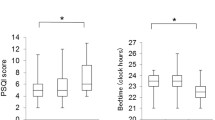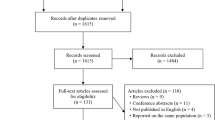Abstract
Background
This present retrospective case control study was designed to evaluate circadian disturbance in patients with chronic idiopathic central serous chorioretinopathy (ICSC).
Methods
Between January 1st, 2012, and November 30th, 2014, 29 consecutive patients with chronic ICSC examined in a referral setting were compared with a gender-matched and age-matched control group of 29 patients. A history of pharmacologic medication (including corticosteroid treatment), sleep disturbance, irregular working hours, cardiovascular risk factors, and depressive anxiety disorders was noted.
Results
The median age of the patients was 52, and in the control subjects it was 50. The male–female ratio for both groups was 4.8:1. Patients with chronic ISCS were more likely to be exposed to irregular working hours (p < 0.01, OR 9.3 [2.29–37.6]) and to present with overweight than the control subjects (p = 0.016). No significant differences were found for sleeping disturbances, pharmacological medication, cardiovascular risk factors, or depressive anxiety disorders.
Conclusions
In this preliminary study, the exposition of irregular working hours as a risk factor for chronic ICSC was identified, which had not been previously reported. If further studies confirm these findings, then employment with regular working hours could be recommended for chronic ICSC patients.
Similar content being viewed by others
References
Spaide RF, Campeas L, Haas A et al (1996) Central serous chorioretinopathy in younger and older adults. Ophthalmology 103(12):2070–2080
Klein ML, van Buskirk EM, Friedman E (1974) Experience with non-treatment of central serous choroidopathy. Arch Ophthalmol 91(4):247–250
Loo RH, Scott IU, Flynn HW Jr et al (2002) Factors associated with reduced visual acuity during long-term follow-up patients with idiopathic central serous chorioretinopathy. Retina 22(1):19–24
Gelber GS, Schatz H (1987) Loss of vision due to central serous chorioretinopathy following psychological stress. Am J Psychiatry 144(1):46–50
Yannuzzi LA (1987) Type-A behavior and central serous chorioretinopathy. Retina 7(2):111–131
Fastenberg DM, Ober RR (1983) Central serous choroidopathy in pregnancy. Arch Ophthalmol 101(7):1055–1058
Gass JDM (1991) Central serous chorioretinopathy and white subretinal exudation during pregnancy. Arch Ophthalmol 109:677–681
Friberg TR, Eller AW (1990) Serous retinal detachment resembling central serous chorioretinopathy following organ transplantation. Graefes Arch Clin Exp Ophthalmol 228:305–309
Polak B, Baarsma G, Snyers B (1995) Diffuse retinal pigment epitheliopathy complicating systemic corticosteroid treatment. Br J Ophthalmol 79:922–925
Gass JDM, Slamovits TL, Fuller DW, Gieser RG, Lean JS (1992) Posterior chorioretinopathy and retinal detachment after organ transplantation. Arch Ophthalmol 110:1717–1722
Matsuo T, Nakayama T, Koyama T, Matsuo N (1987) Multifocal pigment epithelial damages with serous retinal detachment in systemic lupus erythematosus. Ophthalmologica 195:97–102
Bouzas EA, Scott MH, Mastorakos S et al (1993) Central serous chorioretinopathy in endogenous hypercortisolism. Arch Ophthalmol 111:1229–1233
Jain IS, Singh K (1966) Maculopathy: a corticosteroid side-effect. J All India Ophthalmol Soc 14:250–252
Haimovici R, Gragoudas ES, Duker JS, Sjaarda RN, Eliott D (1997) Central serous chorioretinopathy associated with inhaled or intranasal steroids. Ophthalmology 104:1653–1660
Arndt CF, Sari A, Ferre M et al (2001) Electrophysiological effects of corticosteroids on the retinal pigment epithelium. Invest Ophthalmol Vis Sci 42:472–475
Tittl M, Spaide R, Wong D, Pilotto E, Yannuzzi L et al (1999) Systemic findings associated with central serous chorioretinopathy. Am J Ophthalmol 128(1):63–8
Ulhôa MA, Marqueze EC, Kantermann T, Skene D, Moreno C (2011) When does stress end? Evidence of a prolonged stress reaction in shiftworking truck drivers. Chronobiol Int 28(9):810–8
Harris A, Waage S, Ursin H, Eriksen HR (2011) Saliva cortisol levels in construction workers in the Arctic (78°N). Int J Circumpolar Health 70(5):542–51
Cutolo M, Buttgereit F, Straub RH (2011) Regulation of glucocorticoids by the central nervous system. Clin Exp Rheumatol 29(5 Suppl 68):S-19-22
Williamson J, Nuki G (1970) Macular lesions during systemic therapy with depot tetracosactrin. Br J Ophthalmol 54:405–409
Harada T, Harada K. Six (1985) cases of central serous chorioretinopathy induced by systemic corticosteroid therapy. Doc Ophthalmol 60:37–44
Polak BC, Baarsma GS, Snyers B (1995) Diffuse retinal pigment epitheliopathy complicating systemic corticosteroid treatment. Br J Ophthalmol 79:922–925
Yannuzzi LA (1986) Type A behavior and central serous chorioretinopathy. Trans Am Ophthalmol Soc 84:799–845
Michel V, Peinnequin A, Alonso A, Buguet A, Cespuglio R et al (2007) Decreased heat tolerance is associated with hypothalamo-pituitary-adrenocortical axis impairment. Neuroscience 147:522–31
Wright HE, Selkirk GA, McLellan TM (2010) HPA and SAS responses to increasing core temperature during uncompensable exertional heat stress in trained and untrained males. Eur J Appl Physiol 108:987–97
Schobitz B, Reul JM, Holsboer F (1994) The role of the hypothalamic-pituitary-adrenocortical system during inflammatory conditions. Crit Rev Neurobiol 8:263–91
Mustafa S, Al-Bader MD, Elgazzar AH, Alshammeri J, Gopinath S et al (2008) Effect of hyperthermia on the function of thyroid gland. Eur J Appl Physiol 103:285–8
Sprague JE, Banks ML, Cook VJ, Mills EM (2003) Hypothalamic-pituitary-thyroid axis and sympathetic nervous system involvement in hyperthermia induced by 3,4 methylenedioxymethamphetamine (Ecstasy). J Pharmacol Exp Ther 305:159–66
Jung A, Schuppe HC (2007) Influence of genital heat stress on semen quality in humans. Andrologia 39:203–15
Khan VR, Brown IR (2002) The effect of hyperthermia on the induction of cell death in brain, testis, and thymus of the adult and developing rat. Cell Stress Chaperones 7:73–90
Levay EA, Paolini AG, Govic A, Hazi A, Penman J et al (2010) HPA and sympathoadrenal activity of adult rats perinatally exposed to maternal mild calorie restriction. Behav Brain Res 208:202–8
Kilic E, Kilic U, Bacigaluppi M, Guo Z, Abdallah NB et al (2008) Delayed melatonin administration promotes neuronal survival, neurogenesis and motor recovery, and attenuates hyperactivity and anxiety after mild focal cerebral ischemia in mice. J Pineal Res 45:142–8
Belzung C, Griebel G (2001) Measuring normal and pathological anxiety-like behaviour in mice: a review. Behav Brain Res 125:141–9
Paris JJ, Franco C, Sodano R, Freidenberg B, Gordis E et al (2010) Sex differences in salivary cortisol in response to acute stressors among healthy participants, in recreational or pathological gamblers, and in those with posttraumatic stress disorder. Horm Behav 57:35–45
Friedman M, Byers SO, Diamant J, Rosenman RH (1975) Plasma catecholamine response of coronary-prone subjects (type A) to a specific challenge. Metabolism 24:205–210
Williams RB Jr, Lane JD, Kuhn CM et al (1982) Type A behavior and elevated physiological and neuroendocrine responses to cognitive tasks. Science 218:483–485
Harbin TJ (1989) The relationship between the type A behavior pattern and physiological responsivity: a quantitative review. Psychophysiology 26:110–119
Kirschbaum C, Wust S, Hellhammer DH (1992) Consistent sex differences in cortisol responses to psychological stress. Psychosom Med 54:648–657
Yoshioka H, Sugita T, Nagayoski K (1970) Fluorescein angiography findings in experimental retinopathy produced by intravenous adrenaline injection. Folia Ophthalmol Jpn 21:648–652
Nagayoski K (1971) Experimental study of chorioretinopathy by intravenous injection of adrenaline. Acta Soc Ophthalmol Jpn 75:1720–1727
Miki T, Sunada I, Higaki T (1972) Studies on chorioretinitis induced in rabbits by stress (repeated administration of epinephrine). Acta Soc Ophthalmol Jpn 75:1037–1045
Yoshioka H, Katsume Y, Akune H (1982) Experimental central serous chorioretinopathy in monkey eyes, II: fluorescein angiographic findings. Ophthalmologica 185:168–178
Lue YH, Hikim AP, Swerdloff RS, Im P, Taing KS et al (1999) Single exposure to heat induces stage-specific germ cell apoptosis in rats: role of intratesticular testosterone on stage specificity. Endocrinology 140:1709–17
Wakakura M, Song E, Ishikawa S (1997) Corticosteroid-induced central serous chorioretinopathy. Jpn J Ophthalmol 41:180–185
Münch M, Linhart F, Borisuit A, Jaeggi SM, Scartezzini JL (1999) Effects of prior light exposure on early evening performance, subjective sleepiness, and hormonal secretion. Source Endocrinol 140:1709–17
Skarlandtova H, Bicikova M, Neuzil P, Mlcek M, Hrachovina V et al (2012) Might cardiac catheterization influence diurnal rhythm of the steroid stress hormones secretion? Physiol Res 61:25–34
Author information
Authors and Affiliations
Corresponding author
Ethics declarations
Funding
No funding was received for this research.
Conflict of interest
All authors certify that they have no affiliations with or involvement in any organization or entity with any financial interest (such as honoraria, educational grants, participation in speakers’ bureaus, membership, employment, consultancies, stock ownership, or other equity interest, and expert testimony or patent-licensing arrangements), or non-financial interest (such as personal or professional relationships, affiliations, knowledge, or beliefs) in the subject matter or materials discussed in this manuscript.
Ethical approval
All procedures performed in the studies involving human participants were in accordance with the ethical standards of the institutional and/or national research committee and with the 1964 Helsinki declaration and its later amendments or comparable ethical standards.
For this retrospective study, although formal consent is not required, informed consent was obtained from all individual participants included in the study.
Rights and permissions
About this article
Cite this article
Setrouk, E., Hubault, B., Vankemmel, F. et al. Circadian disturbance and idiopathic central serous chorioretinopathy. Graefes Arch Clin Exp Ophthalmol 254, 2175–2181 (2016). https://doi.org/10.1007/s00417-016-3378-y
Received:
Revised:
Accepted:
Published:
Issue Date:
DOI: https://doi.org/10.1007/s00417-016-3378-y




